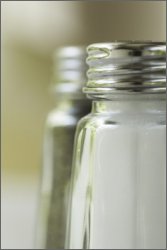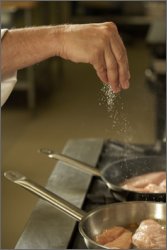Salt: What You Really Need to Know About the Harmful & Healthful Effects of Sodium
by www.SixWise.com
Sodium is essential to the human body, helping to carry nutrients
into cells, regulate body functions such as blood pressure
and fluid volume, and keep the pressure balance normal on
the lining of blood vessels.
"You cannot exist without sodium," says Alicia
Moag-Stahlberg, a research nutritionist at Northwestern University
Medical School in Chicago and a spokeswoman for the American
Dietetic Association. "But the amount we need is minor."
|

"Seventy-five percent of the sodium consumed is
in processed foods," says the FDA's Ellen Anderson,
Ph.D.
|
This may be why the Institute of Medicine recently lowered
the recommended daily sodium intake from 2,400 milligrams
(mg) a day to 1,500 mg or less.
Many people routinely eat at least 4,000 mg a day, with some
consuming amounts up to 6,000 mg, says Moag-Stahlberg.
"Many people argue that a healthy kidney can get rid
of it [the excess], but in many cases, that happens at the
expense of losing calcium," she says.
Salt: Is it Healthy or Harmful?
Whether or not extra salt in the diet is harmful is the topic
of great debate. According to conventional medical thought,
including what is advised by federal organizations, people
can reduce their chances of developing high blood pressure
by consuming less salt (which is sodium chloride).
Many studies have found that diets high in sodium are associated
with higher blood pressure, along with an increased amount
of calcium excreted in the urine. Eating less salt, say some,
can therefore potentially decrease calcium loss from bone,
reducing the risk of osteoporosis and bone fractures.
However, some studies, including one led by Hillel W. Cohen,
an assistant professor of epidemiology and population health
at Albert Einstein College of Medicine in New York City, have
found different results.
Cohen's team collected data on 7,278 people who participated
in the Second National Health and Nutrition Examination Survey.
After assessing deaths from heart disease and any other cause
during a 13-year follow-up, they found that the less salt
people ate, the greater their risk of dying from heart disease.
"We believe these data do not support" the current
guidelines, said Cohen. "We are urging those who make
these guidelines to go back to their data and look at additional
data prior to making universal recommendations."
Specifically, the researchers found:
-
Consuming less than 2,400 mg of salt a day was associated
with a 50 percent higher risk of heart disease.
-
For each 1,000-mg reduction in salt intake, the risk
of cardiovascular mortality rose by 1 percent.
Cohen suggests that optimal salt intake may depend on the
individual.
"It is likely that there are differences between individuals
with regard to sodium intake," he said. "And it's
clear that the data do not support the current recommendations
... From a biological standpoint, if one's kidneys are
working reasonably well, sodium within the usual range of
intakes shouldn't be a problem."
Not All Salt is the Same
|

Watching your salt intake? When eating out, tell your
server that you don't want salt added to your meal.
Most chefs will be happy to comply.
|
One thing's for certain in all of this: the majority of sodium
that Americans eat comes from processed
foods.
"Even though we think that it would be best to lower
sodium in the diet to 1,500 mg," says Norman Kaplan,
a hypertension expert at the University of Texas Southwestern
Medical Center in Dallas, "we have to face the reality
that we are living in an industrialized, commercialized world
where average sodium consumption is high because food processors
have been putting so much salt in our food."
"Seventy-five percent of the sodium consumed is in processed
foods," says Ellen Anderson, Ph.D., physical chemist
in the Food and Drug Administration's Office of Food Labeling.
"What the food industry includes during processing, we
can't take out."
To get an idea of just how much sodium is in processed foods,
consider the sodium in the following:
-
Bacon, lettuce, and tomato sandwich (8 oz.) -- 1,560
mg
-
Sbarro Supreme Pizza (1 slice) -- 1,580 mg
-
Corned beef sandwich with mustard (9 oz.) -- 1,920
mg
-
Lasagna (2 cups) -- 2,060 mg
-
Panera Smokehouse Turkey Panini on Artisan Three Cheese
-- 2,320 mg
-
Ham sandwich with mustard (9 oz.) -- 2,340 mg
-
Chipotle Chicken Burrito, with cheese and salsa --
2,490 mg
-
Pizza Hut Meat Lover's Stuffed Crust Pizza, large
(2 slices) -- 2,500 mg
-
Chef salad with dressing (5 cups) -- 2,510 mg
-
Kung Pao chicken with rice (41/2 cups) -- 2,610 mg
Most of the salt used in processed foods, as well as the
salt that is typically thought of as "table salt,"
is refined and contains chemicals such as moisture absorbents
and iodine. Plus, it is dried at over 1,200 degrees Fahrenheit,
which alters the natural chemical structure
of the salt and takes away many natural benefits.
Further, table salt often contains preservatives that do
not have to be listed on the packaging, along with additives
like calcium carbonate, magnesium carbonate, and aluminum
hydroxide to improve the ability of the salt to pour.
Pure Himalayan crystal salts, along with sea salts (if you
can be assured they are not full of pollutants from the sea)
can offer many more benefits to you than typical table salt,
including supplying your body with healthy trace minerals
-- and no environmental pollutants.
If you would like to include salt in your diet, Sixwise.com
recommends one of the pure, natural salts mentioned above.
To minimize typical, refined sodium chloride in your diet,
try these tips:
-
Be aware that there are often high levels of salt in
fast food, condiments, restaurant meals, sauces, snacks
and frozen
dinners.
-
Choose fresh foods, such as plain meats, fish, fruits
and vegetables whenever possible.
-
Read labels on processed
foods you do buy, and watch out for high levels of
sodium.
-
When eating out, tell your server that you don't want
salt added to your meal.
-
If you add salt to your cooking, do it at the end. Cooking
can lessen salt's flavor, so adding it at the end will
give you more taste with a smaller amount.
Recommended Reading
Chromium:
It May Help Prevent Heart Attacks, Improve Cholesterol &
Much More ... So Are You Getting Enough?
The
8 Top Dietary Mistakes "Healthy Eaters" Make
Sources
America's Pressure
Cooker
Forbes:
Low-Salt Diets May Harm Heart
A
Pinch of Controversy Shakes up Dietary Salt
Dietary
Guidelines